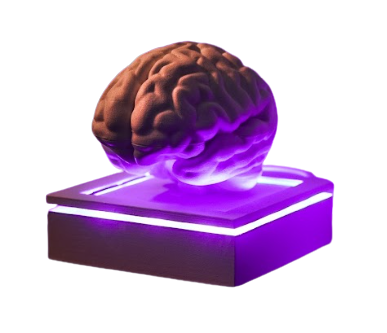
An aesthetic piece for ‘brain’ storming
Sometimes, a design should not just look cool. It should be cool.
In collaboration with Ergonic the task was to create a design for people interested in psychology, and neuroscience, or even people who may want to adorn their study tables, office spaces, and living rooms with something ‘cool.’ However, the major focus was on creating something unique yet meaningful for the category of people described. The open-ended, vague statement was a doorway to great ideas and innovations that led us to create the design for ‘NeuroNova.’
Translating these requirements into something that can be designed and manufactured with engineering specifications was not an easy task. However, we studied the user persona of the following people in order to start thinking about what they would keep in their desks that would be cool and inspire them:
psychology, neuroscience, or medical field-based people who may keep it at their office desks
working professionals who want something cool for their living spaces
students in universities who may want to keep it on their study tables
Following an extensive examination, it was determined that merging the characteristics of a "lamp" and a "brain" was viable, as it fulfills a universal functionality of light provision and prominently showcases one's personal interests related to the human brain and its endeavors.
By harnessing the illuminating effects emanating from the brain, it has the potential to create an ideal ambiance for brainstorming, productive contemplation, and relaxation. Simultaneously, these features enhance the user's image, projecting an impression of boldness, sophistication, and ingenuity.
While benchmarking other designs in the market, we clearly saw a gap in the market of having ‘true’ 3D brain lamps; instead, there are multiple designs of just a 2D brain-shaped glass that stands on a base, kind of like a small trophy. Albeit cool, we wanted to achieve even cooler.
Keeping this in mind, we started to find the most exact modeling of the brain and then refined our CAD model extensively so that it can be 3D printed.
The focus was on creating the base now, where the brain will stand on. There would be LED strip lights contained within the base and a thin slit kept out for the light to be emitted. The first iteration of the base had the following design.
The central aperture found on the base is specifically designed to accommodate the unique shape of the brain, allowing for a secure connection. The top layer will rest upon the base, while inside it, LED strip lights will be wrapped in parallel to the surface. Once placed on the base, these internal LEDs will illuminate the brain, accentuating its presence.
Initially, we incorporated a slot on the top layer for the LED's entry and exit point, enabling connection to the battery or remote control housed within the casing. However, although the slot is kept, we decided to remove the battery or remote casing as it compromised the aesthetic appeal and hindered easy access to the object's activation button. By adopting a more traditional lamp design, where the button or remote is conveniently accessible while attached to the lamp, the overall look remains sleek and unobstructed.
So far to give an idea of how it may appear, it was rendered with blue light settings to give the following look.
NeuroNova Contextual Photoshoot Front View
Surprisingly, once we completed the manufacturing process and assembled all the components, we came to the realization that the emphasis should not be on highlighting the brain itself, but rather on creating an illuminating effect that accentuates the surrounding area, causing the design to stand out. To achieve this, we discovered that a precisely measured gap of 3 mm between the top layer and the base was essential. To maintain this gap without obstructing the emitted light, we ingeniously devised small spacers. These spacers serve to elevate the top layer and maintain the desired distance from the base, allowing the light to seep out and produce the desired effect without any obstruction, as depicted below.
As can be seen, there is a square border shadow that surrounds the 3D brain lamp. This was important to create the effect of ‘focus’. The sharpness of it and the light combined creates a shift in focus from within, to outside, thus making the piece aesthetic.
It is to be noted that while designing, we always kept in mind the type of colored light, the amount of light, and the directionality of light that needs to be there such that it impacts the brain in different ways as described below.
Based on all these, we crafted the final design which we termed ‘NeuroNova’ stemming from the concept of neurons (emphasizing how connections form in the brain) and Supernova (emphasizing star/light/lamp effect). The final design has 12 cm x 12 cm x 12 cm dimensions and weigh about 200 grams.
Top, Front, and Isometric Exploded View of NeuroNova
NeuroNova Contextual Photoshoot Isometric View
NeuroNova Contextual Photoshoot Top View











